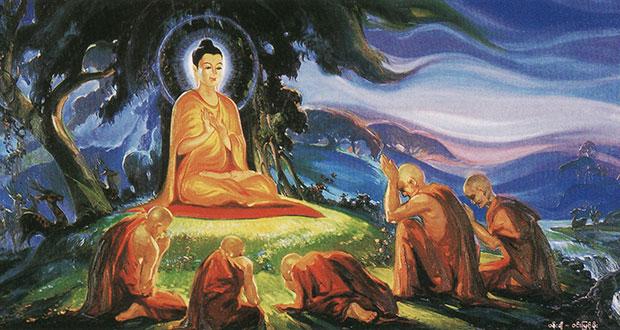Misconception about the Noble Eightfold Path
The Lord Buddha introduces the ‘middle path’ in his first sermon the Dhammacakkapawattana sutta, as the Fourth Noble Truth which is the path to end the suffering. In this great sermon the Lord Buddha explains that one must abandon the two extreme ends; one is addiction to indulgence in sensual pleasures and the other is addiction to self-mortification and follow the middle path. This is commonly misinterpreted by many Buddhists. Their interpretation is that one must not go to extremes in life and follow a middle path. For example; one must not get too angry, which is one end, or not get angry at all, which is the other end, instead one should only try to moderate anger. Another example is one must not eat or drink too much or not eat or drink at all, they must do it moderately.
This is a wrong idea because in the same sutta the lord Buddha explains what the middle path is. It is the Noble Eight-fold path. It is the path realized by the Lord Buddha as the way to end suffering. It has eight steps that one must follow and strive on, in order to be free from suffering. And Lord Buddha describes that this middle path produces vision, produces knowledge — leads to calmness, to insight, to enlightenment, and to Nibbana.
‘Katamā ca sā, bhikkhave, majjhimā paṭipadā tathāgatena abhisambuddhā cakkhu·karaṇī ñāṇa·karaṇī upasamāya abhiññāya sambodhāya nibbānāya saṃvattati?
“And what is the middle path realized by the Buddha that —gives vision gives knowledge — leads to calmness, to insight, to enlightenment, and to Nibbana?
Ayam·eva ariyo aṭṭhaṅgiko maggo, seyyathidaṃ:
It is precisely this Noble Eightfold Path, which is:
sammā·diṭṭhi sammā·saṅkappo sammā·vācā sammā·kammanto sammā·ājīvo sammā·vāyāmo sammā·sati sammā·samādhi.
Sammā diṭṭhi – is the knowledge about the Four Noble Truths.
Sammā saṅkappa – the correct intention which is threefold, Nekkhamma saṅkappa – thoughts devoid of sensual pleasure, abyāpāda-saṅkappa – thoughts of good will and avihiṃsā-saṅkappa – thoughts of benignness
Sammā vācā – refrain from lying, divisive speech, harsh speech, and pointless speech.
Sammā kammanta – abstain from killing, stealing and sexual misconduct.
Sammā ājīva – live a correct life by abandoning all wrong ways of making a living.
Sammā vāyāma – this is fourfold;
• Strive to prevent the arising of unarisen evil unwholesome mental states.
• Strive to eradicate evil unwholesome mental states that have arisen.
• Strive to develop wholesome mental states that have not yet arisen.
• Strive to maintain and further develop wholesome mental states that have arisen.
Samma sati – practice the Four-fold mindfulness – the Satarasatipatthana
Samma samādhi – develop the four stages of higher concentrations, which is known as jhāna- absorptions.
Therefore, the middle path is not living a moderate life by avoiding the extreme. It has precise steps that are very briefly explained above. It is the path that puts an end to all suffering. If a person develops the middle path, he/she can be free from the long and dangerous sansaric journey.
Misconception about the Kalama Sutta
Another misconception harbored by Buddhists with regard to the famous Kalama sutta is that Buddha said, not to accept anything even if it was told by the Buddha himself, but to inquire with your own intelligence and only accept it if you yourself see it as true or if you think it is correct.
For example, if a person were to consider this part of the sutta in isolation, he could misleadingly conclude that, though the Buddha has said anger is wrong, according to his/her intelligence there are instances when anger can be justifiable. In fact he/she could see anger as a necessity and refuse the word of the Buddha. And he/she would think that it is correct because the Buddha himself has said not to accept anything just because he said it.
The danger of taking this section of the sutta and giving it a wrong interpretation is immense. This could lead a person to refuse vital parts of Dhamma that he/she finds difficult to understand or is above his/her intelligence; such as the fundamental teachings of ‘anatta’, ‘asubha’ or ‘paticcasamuppada’ which require so much effort to understand or to even have an idea about. Instead of trying to understand the noble Dhamma with faith he/she would dismiss it thinking the Buddha advised to do so. Thus let us try to understand on what basis did Buddha encourage free inquiry and how can such inquiry help us accept or reject an idea, teaching or doctrine.
In Kalama sutta, the Lord Buddha visits a village called Kesaputta where a community called Kalama lives. The Kalamas are very wise. They tell the lord Buddha that many teachers come to their village from time to time and say that only their doctrine is correct and all other doctrines are wrong. So the Kalamas ask the Lord Buddha how to figure out who is telling the truth and who is lying, and also whose teaching to accept and whose teaching to reject.
The Lord Buddha commends them for their intelligence and agrees that their doubt has arisen in the correct place.
Thereafter Lord Buddha sets forth the principles that should be followed by a seeker of truth.
“Kalamas, do not accept (something) upon repeated hearing; nor upon tradition; nor upon rumor; nor upon what is in a scripture; nor upon surmise; nor upon an axiom; nor upon specious reasoning; nor upon a bias towards a notion that has been pondered over; nor upon another’s seeming ability; nor upon the consideration, ‘The monk is our teacher.’
Kalamas, when you yourselves know: ‘These things are bad; these things are blamable; these things are censured by the wise; undertaken and observed, these things lead to harm and ill,’ abandon them.”
Next Lord Buddha explains how the presence of greed, hatred and delusion can lead to harm and suffering while absence of greed, hatred and delusion leads to welfare and happiness. Sadly this crucial explanation has been left out in the common usage of the sutta.
“What do you think, Kalamas? Does greed appear in a man for his benefit or harm?” — “For his harm, venerable sir.” — “Kalamas, being given to greed, and being overwhelmed and overcome by greed, a person takes life, steals, commits adultery, and tells lies; he/she prompts another too, to do likewise. Will that be for his harm and ill?” — “Yes, venerable sir.”
“What do you think, Kalamas? Does hate appear in a man for his benefit or harm?” — “For his harm, venerable sir.” — “Kalamas, being given to hate, and being overwhelmed and overcome by hate, a person takes life, steals, commits adultery, and tells lies; he/she prompts another too, to do likewise. Will that be for his harm and ill?” — “Yes, venerable sir.”
“What do you think, Kalamas? Does delusion appear in a man for his benefit or harm?” — “For his harm, venerable sir.” — “Kalamas, being given to delusion, and being overwhelmed and overcome by delusion, a person takes life, steals, commits adultery, and tells lies; he/she prompts another too, to do likewise. Will that be for his harm and ill?” — “Yes, venerable sir.”
Thus unwholesome acts born of greed, hatred and delusion should be abandoned because such acts lead to harm and suffering.
Likewise Lord Buddha pointed out wholesome acts performed in the absence of greed, hatred and delusion lead to welfare and happiness and therefore such acts should be pursued and carried out.
Moreover Lord Buddha sums up the basis for free inquiry in the following manner;
Kalamas, if you know for yourselves that “These qualities are wholesome; these qualities are blameless; these qualities are praised by the wise; these qualities, when adopted and carried out, lead to welfare and to happiness”, then you should accept and abide by them.
Even today a person can use this framework to make a wise and informed decision on accepting or rejecting a doctrine or teaching.
All things considered the misconception regarding the Kalama sutta is a classic example of the danger of making arbitrary conclusions without studying a sutta with due diligence.
In conclusion it would help to bear in mind the following simile by Lord Buddha;
Just as a person that grasps a snake by its coils or the tail gets bitten by the snake and suffer death or come to deadly suffering, a person who grasp the dhamma in the wrong way (failing to ascertain the purpose and meaning of the dhamma content) would come to great harm and suffering.
– Prajapathi Jayawardena











Recent Comments